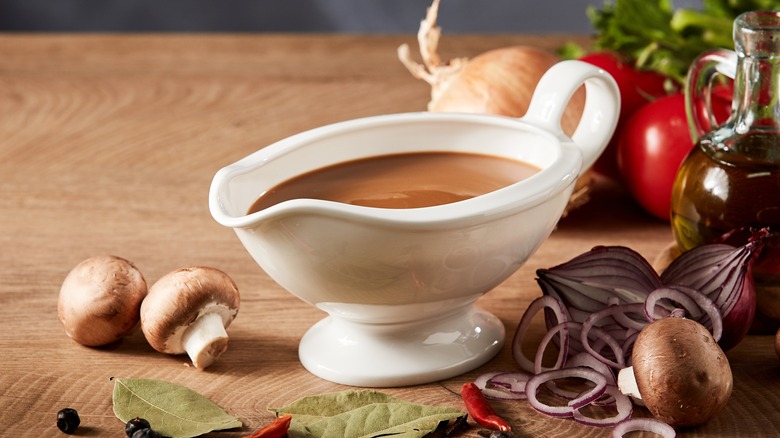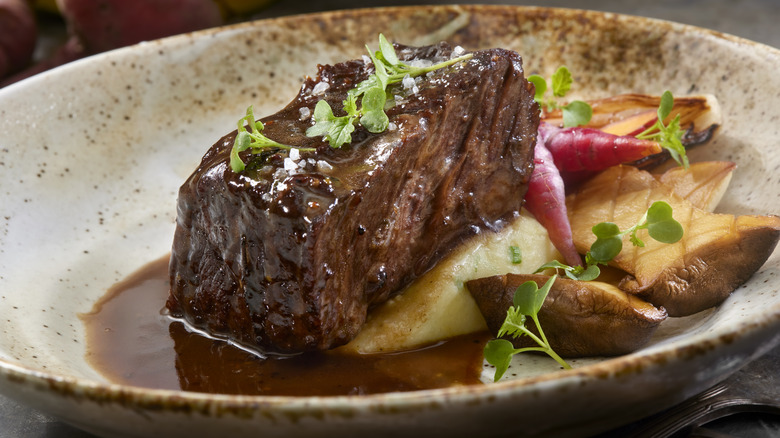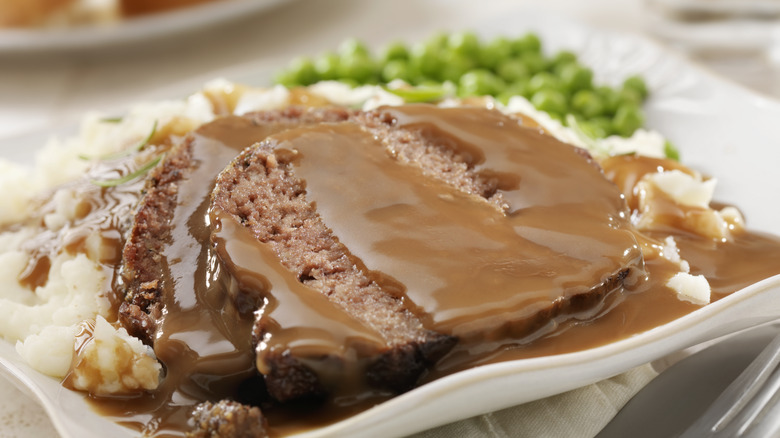What Sets Au Jus Apart From Standard Gravy?
In cooking, it is sometimes difficult to distinguish one recipe from another. Some are so similar that only the minutest of ingredient changes separates them from one another. Such is the case with au jus and standard gravy. Both are derived from the same base but diverge in terms of use, and the addition, or lack thereof, of certain ingredients.
Both au jus and gravy are made from a base of meat drippings. These drippings are a flavorful rendering of fat and liquids which, when combined, create a wonderfully savory sauce. Where au jus and standard gravy depart from one another is what happens to the sauce after the meat is done cooking. Au jus is basically a concentrated version of drippings, whereas gravy is the same thing, only it gets thickened using a roux or another type of thickening agent.
In terms of flavor, the difference lies with the cook's personal preference for herbs and spices, which dictate how the meat drippings are seasoned. Application-wise, both au jus and gravy can be used for similar purposes.
Au jus is thin and savory
Au jus is a sauce of French origin. Literally translated to "with juice," the classical preparation of this sauce begins with those tasty drippings. The idea is to boost flavor, bringing even more of that meaty goodness to a dish. Au jus is generally served alongside roasted or grilled meats such as lamb or pork, though the sauce is most commonly associated with beef. One of the most popular uses for au jus is as a dipping sauce for a French dip sandwich. When used as a thin gravy, say for pot roast or prime rib, au jus brings added moisture and fat.
Au just sits somewhere between a broth and gravy. It is more intensely flavorful than broth thanks to the drippings, and it is not a standard gravy because it is far too thin. Instead, au jus is a concentration of beef juices that is just thick enough to lightly coat the meat. It is often flavored with herbs like thyme and rosemary, and can sometimes be slightly acidic if vinegar is added to the recipe.
Au jus is made by simmering the juices in the roasting pan, taking full advantage of the brown bits stuck at the bottom, which can be loosened with a wooden spoon. Butter may or may not be added to bring extra richness, while also thickening the sauce. After a few minutes worth of simmering, the sauce should be reduced and strained for a smooth consistency.
Gravy is thick and velvety
Standard gravy uses a thickening agent, traditionally a roux, which is a French practice of mixing melted butter and flour together over heat to form a sort of loose paste. Once added to a sauce, the roux will thicken it considerably, providing an opaque color and velvety richness. Thickened gravy is common across several different food traditions, but is very notable in its generous applications in English cuisine, where it is liberally poured over roast beef or chicken, jacket potatoes, and Yorkshire pudding. In the United States, it most commonly accompanies the Thanksgiving turkey and gets poured atop stuffing and other side dishes.
Like au jus, gravy begins with the meat drippings. This could be from poultry like chicken, or meats like beef, lamb, and pork. Similarly, the standard gravy gets simmered down in its pan for several minutes in order to concentrate flavors. Additional ingredients are often added, including rosemary and thyme, and even some extra broth to make the sauce stretch.
The roux is added towards the end. You could also just toss in some straight flour, cornstarch, or arrowroot powder to thicken the gravy. Incorporate the thickening agent quickly to avoid any lumps. Unlike au jus, which can be used as a dipping sauce, standard gravy, as we've seen, is most often poured over meat and side dishes. However, you could also use the gravy as a sauce for pasta, add it to thicken soup, or as a sauce for a hot sandwich.


